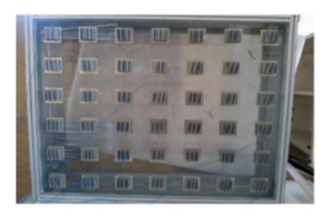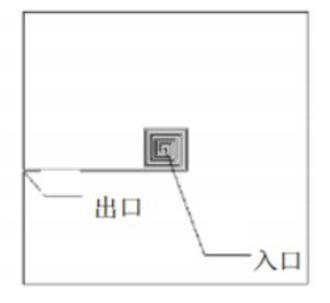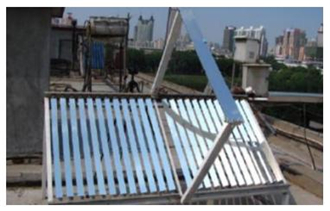1.1 Research on the heat dissipation of the single cell
A single cell generally only needs to be cooled passively, and it is still effective even under high light condensing multiples. This is because a single cell has a large heat dissipation area. In addition to the surrounding and back of the cell, the backplane in contact with the cell can also dissipate heat, spreading to the surrounding space through the heat sink. Fei Wang from the Inner Mongolia University of Technology designed a CPV/T air-cooling model at a concentration of 1200 X, as shown in Figure 3. In the hot and windless summer, the surface temperature of the cell can be controlled at about 65℃, and the electrical efficiency of the module is above 29% under different irradiation. However, after the forced air cooling module is added, uneven heat dissipation is more likely to occur due to the natural heat dissipation of the module being blocked. However, related scholars have proposed some novel cooling and heat exchange methods under high light concentrating conditions. Shengnan Lei used 5% pf SiO2 nanofluids with spiral tube microchannels, as shown in Figure 2 to test the cell temperature at different mass flow rates. The temperature is controlled below 46.2℃and the average photoelectric conversion efficiency is increased to 15.85%.

Figure 1 A module composed of a single cell with fins

Figure 2 Spiral tube microchannel
1.2 Research on heat dissipation of linearly arranged cells
Linear arranged cells usually use trough mirrors or linear Fresnel lenses. Compared with the circular Fresnel lens of a single cell, the linearly arranged cell only needs a single-axis tracking system. Although the linear arrangement of the cells results in the contact of two adjacent batteries, which reduces the heat dissipation area. However, the two sides and back of the batteries can still dissipate heat. As shown in Figure 3, the linear strip flat mirror condenser is also a widely used device. It is simple to manufacture, and has low costs, and low maintenance costs. Equipping a daylight tracking system with low power can provide a more modular and compact design and become the ideal condenser for concentrating photovoltaic systems with medium and low power. The linear arrangement of batteries is relatively special, and there are few corresponding studies at home and abroad. The specific results are shown in Table 1.

Figure 3 Linear strip flat mirror condensers
Table 1 Research on heat dissipation of linearly arranged cells
| Researchers | Cooling methods | Cooling media | Concentration ratio | Research results |
| Sonneveld and others | Liquid convective cooling water | Water | 25 X | Fix the linear Fresnel lens, and place the cell module on the focus through the tracking system. The thermal efficiency is 56%, and the electrical efficiency is 11%, which meets the needs of light, electricity and heat in the greenhouse. |
| Yong Sun | Liquid immersion cooling |
Dimethicone | 9.61 X | The DNI on the surface of the cell can reach 920 W/m2. The average temperature of the module can be maintained at 31 to 20°C, and the convective heat transfer coefficient can reach 280 to 1000 W/(m2. K). |
1.3 Research on heat dissipation of dense module cells
Dense modular cells usually use high light concentration multiples (greater than 150X). Compared with the aforementioned two structures, this modular does not have the advantage of heat dissipation on edges, and each cell can only use its rear side for heat dissipation. Therefore, the entire heat load must be dissipated in a direction perpendicular to the surface of the cell. In this case, only active cooling technology can be used. At this time, the thermal resistance of the system is required to be less than 10 to 4 K. m/W. Only jet impact and micro-channel heat dissipation can achieve such a low value. The other two-phase flow is also a good choice. Jun Dong from Harbin Institute of Technology designed a fractal micro-channel radiator for photovoltaic cells of 10 X 10 close-packed modules, as shown in Figure 4. When the direct solar radiation is 1000W/m2 and the light concentration ratio is 500X, the inlet speed of the cooling medium water is controlled to be greater than 0.6264 m/s, which can make the surface temperature of the battery chip not higher than the calibrated upper limit of 80°C. At the same time, the manifold channel radiator can maintain very good temperature uniformity.

Figure 4 Fractal micro-channel heat sinks